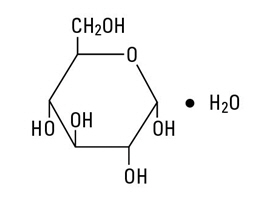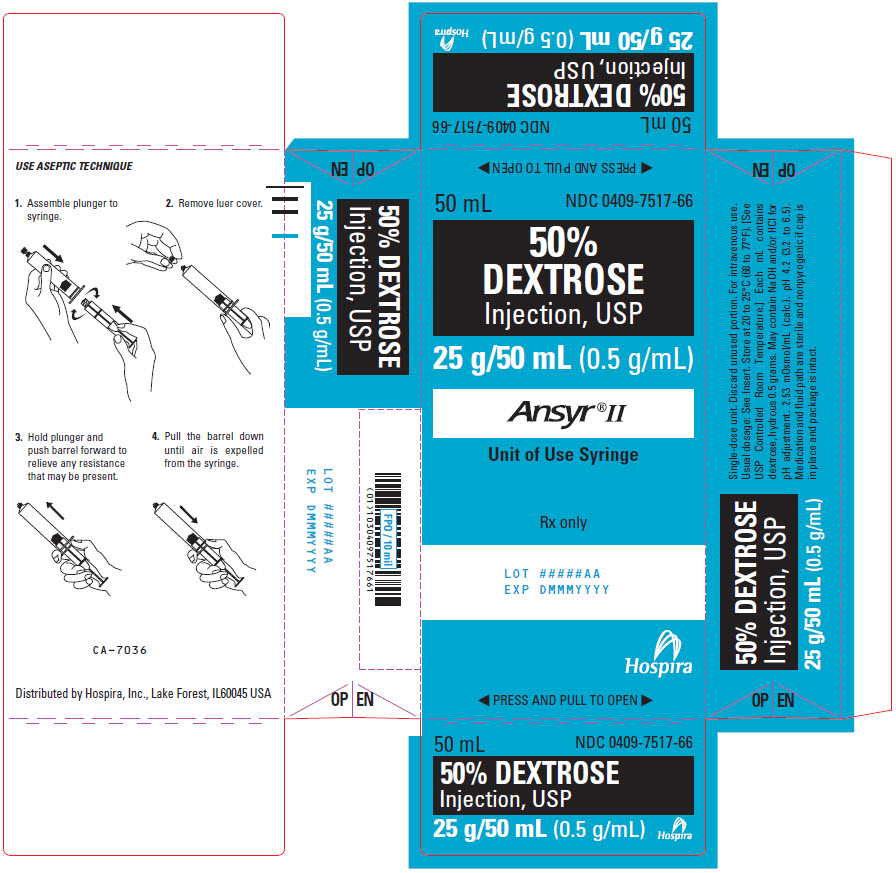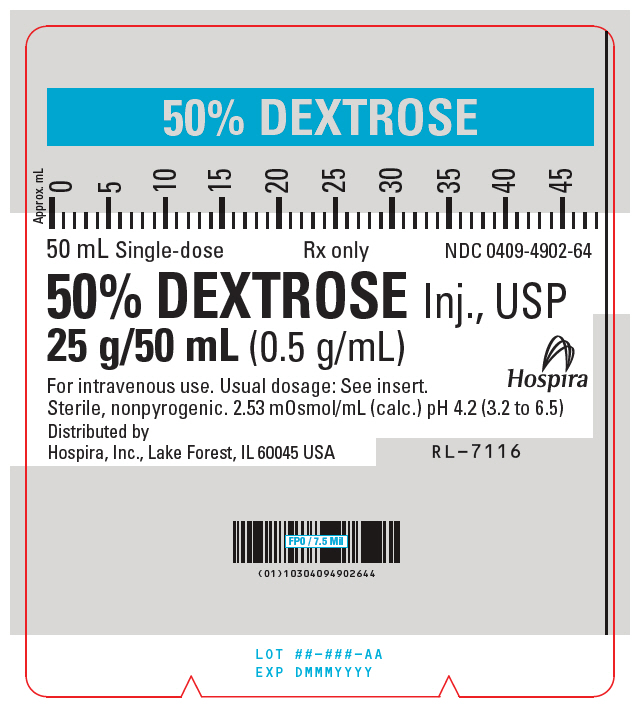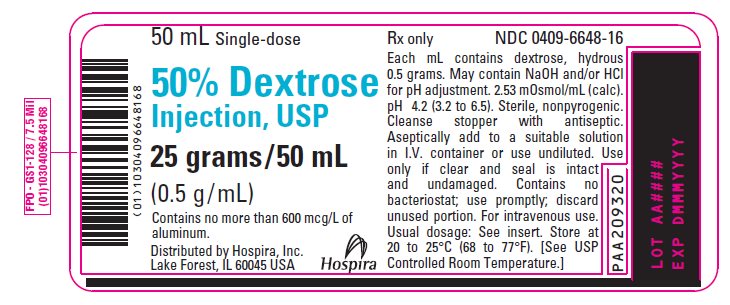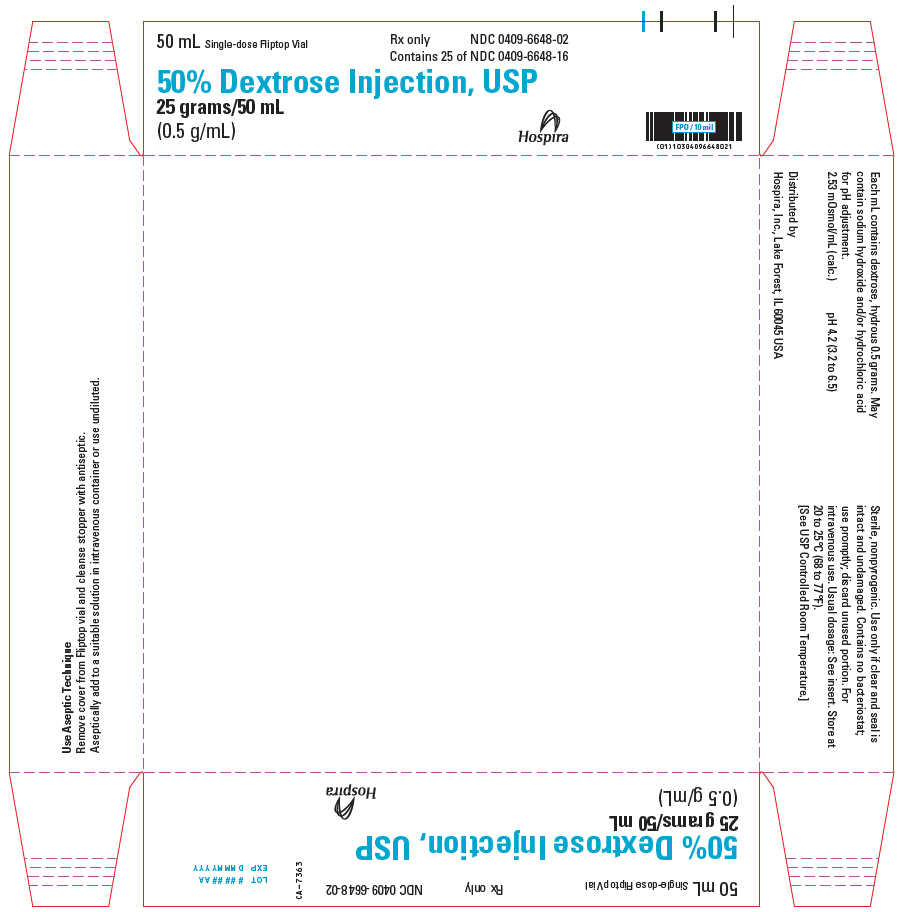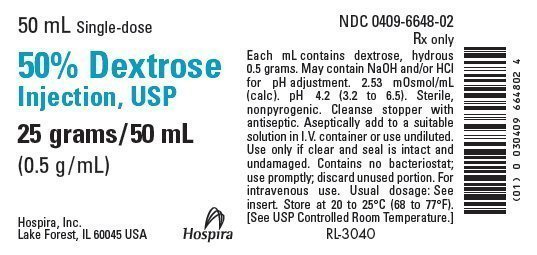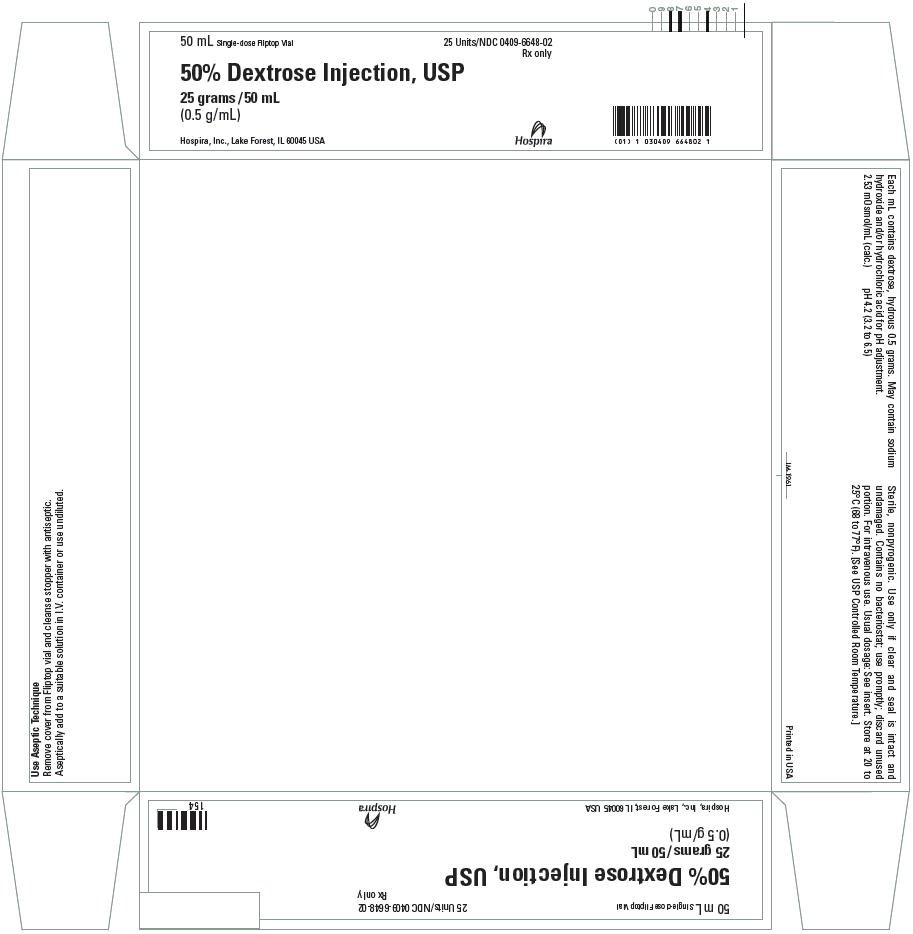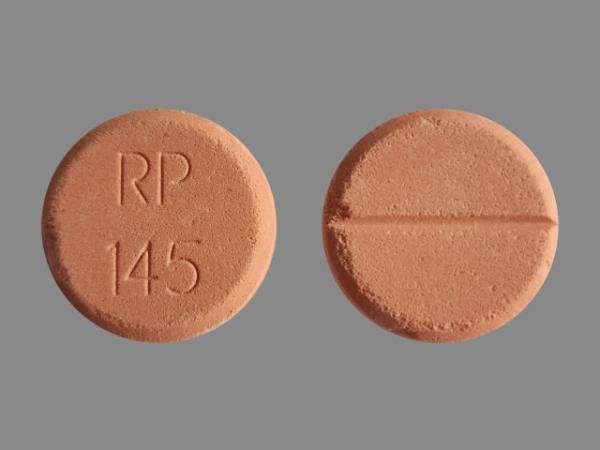Dextrose Injection: Package Insert / Prescribing Info
Package insert / product label
Generic name: dextrose monohydrate
Dosage form: injection, solution
Drug class: Glucose elevating agents
Medically reviewed by Drugs.com. Last updated on Aug 17, 2025.
On This Page
- Indications and Usage
- Dosage and Administration
- Dosage Forms and Strengths
- Contraindications
- Warnings and Precautions
- Adverse Reactions/Side Effects
- Drug Interactions
- Use In Specific Populations
- Overdosage
- Description
- Clinical Pharmacology
- Nonclinical Toxicology
- How Supplied/Storage and Handling
- Storage and Handling
Highlights of Prescribing Information
DEXTROSE injection, for intravenous use
Initial U.S. Approval: 1940
Recent Major Changes
Indications and Usage for Dextrose Injection
Dextrose Injection (50%) is indicated for the treatment of insulin-induced hypoglycemia (e.g., hyperinsulinemia, insulin shock) in adults and pediatric patients 2 years of age and older. (1)
Dextrose Injection Dosage and Administration
- •
- Only for intravenous infusion. Do not administer subcutaneous or intramuscularly. (2.1)
- •
- Adults and Pediatric Patients 12 years of Age and Older
- o
- Administer into a central vein or large peripheral vein.
- o
- Recommended dosage is 10to 25 grams (20 to 50 mL) administered once. Repeated doses may be administered as clinically appropriate. (2.2)
- •
- Pediatric Patients 2 to 11 Years of Age
- o
- Administer into a central vein
- o
- Appropriate dosage depends on the age, weight, clinical and metabolic conditions of the patient, and concomitant therapy. (2.2)
- •
- Maximum rate of dextrose administration without producing hyperglycemia is o.5 g/kg of body weight/hour. (2.2)
- •
- See full prescribing information for more information on preparation and administration instructions. (2.12.2)
Dosage Forms and Strengths
Injection: 50% (25 g/50 mL) (500 mg/mL) of single-dose dextrose hydrous supplied as: (3)
- •
- LifeShield® Abboject® Unit of Use Syringe with Male Luer Lock Adapter and protected needle
- •
- Abboject® Syringe with Male Luer Lock Adapter
- •
- Ansyr® II Plastic Syringe with syringe and barrel detached
- •
- Fliptop Vials
Contraindications
Warnings and Precautions
- •
- Hyperglycemia or Hyperosmolar Syndrome: Monitor blood and urine glucose; administer insulin as needed. (5.1)
- •
- Hypersensitivity Reactions: Monitor for signs and symptoms and discontinue infusion immediately if reaction occurs. (5.2)
- •
- Phlebitis and Thrombosis: Remove catheter as soon as possible if thrombophlebitis develops. (2.1, 5.3)
- •
- Electrolyte Imbalance and Fluid Overload: Monitor changes in fluid balance, electrolyte concentrations, and acid-base balance during administration. (5.4)
- •
- Hyponatremia: Monitor serum sodium and chloride concentrations, fluid status, acid-base balance, and neurologic status. (5.5)
- •
- Potential Aluminum Toxicity for Patients with Immature or Impaired Renal Function: Prolonged administration of Dextrose Injection (50%) may lead to toxic levels of aluminum in pediatric patients with immature renal function or renal impairment, and in adults with renal impairment. (5.6)
Adverse Reactions/Side Effects
The most common adverse reactions are hyperglycemia, hypersensitivity reactions, hyponatremia, infection (both systemic and at the injection site), vein thrombosis, phlebitis, and electrolyte imbalance. (6)
To report SUSPECTED ADVERSE REACTIONS, contact Pfizer, Inc. at 1-800-438-1985 or FDA at 1-800-FDA-1088 or www.fda.gov/medwatch.
Drug Interactions
Effects on Glycemic Control and Electrolyte Balance: Monitor blood glucose concentrations, fluid balance, serum electrolyte concentrations, and acid-base balance. Avoid use of Dextrose Injection in patients receiving drugs associated with hyponatremia. (7.1)
Use In Specific Populations
Pediatric Use: Increased risk of hypoglycemia/hyperglycemia and imbalances in fluid/electrolytes; monitor serum glucose concentrations, volume status, and electrolytes. Use a different dextrose product if treatment is necessary in a pediatric patient younger than 2 years old. (8.4)
Revised: 7/2025
Full Prescribing Information
1. Indications and Usage for Dextrose Injection
Dextrose (50%) Injection is indicated for the treatment of insulin-induced hypoglycemia (e.g., hyperinsulinemia, insulin shock) in adults and pediatric patients 2 years of age and older.
2. Dextrose Injection Dosage and Administration
2.1 Important Preparation and Administration Instructions
- •
- Parenteral drug products should be inspected visually for particulate matter and discoloration prior to administration. Do not use Dextrose Injection (50%) if the solution is cloudy or the seal has been broken.
- •
- Obtain a blood glucose level prior to administering Dextrose Injection (50%). However, in an emergency, administer Dextrose Injection (50%) promptly without awaiting blood glucose test results.
- •
- Do not administer Dextrose Injection (50%) simultaneously with blood through the same infusion set because pseudoagglutination of red blood cells may occur.
- •
- Administer Dextrose Injection (50%) intravenously. Do not administer Dextrose Injection (50%) subcutaneously or intramuscularly.
- •
- Discard the unused portion.
2.2 Recommended Dosage and Administration
Adults and Pediatric Patients 12 Years of Age and Older
When possible, administer Dextrose Injection (50%) into a central vein or large peripheral vein because Dextrose Injection (50%) has an osmolarity greater than 900 mOsm/L and can cause venous irritation.
The recommended dosage of Dextrose Injection (50%) is 10 to 25 grams (20 to 50 mL) of Dextrose Injection (50%), administered once via intravenous infusion. Repeated doses may be administered as clinically appropriate.
Slowly infuse Dextrose Injection (50%) to reduce the risk of developing hyperglycemia and to minimize venous irritation [see Warnings and Precautions (5.1, 5.3)]. The maximum rate at which Dextrose Injection (50%) can be infused without producing hyperglycemia is 0.5 g/kg of body weight/hour.
Pediatric Patients 2 to 11 Years of Age
Administer Dextrose Injection (50%) into a central vein. Avoid administration of Dextrose Injection (50%) into a peripheral vein because Dextrose Injection (50%) has an osmolarity greater than 900 mOsm/L and can cause venous irritation [Warnings and Precautions (5.3)]. If central venous access cannot be obtained, consider using an alternative commercially available dextrose product with a lower concentration.
The appropriate dosage of Dextrose Injection (50%) depends on the age, weight, clinical and metabolic conditions of the patient, and concomitant therapy.
Slowly infuse Dextrose Injection (50%) to reduce the risk of developing hyperglycemia and to minimize venous irritation [see Warnings and Precautions (5.1, 5.3)]. The maximum rate at which Dextrose Injection (50%) can be infused without producing hyperglycemia is 0.5 g/kg of body weight/hour.
3. Dosage Forms and Strengths
Injection: 50% (25 g/50 mL) (500 mg/mL) of dextrose hydrous in a clear, colorless solution supplied as:
- •
- Single-dose LifeShield® Abboject® Unit of Use Syringe with Male Luer Lock Adapter and protected needle
- •
- Single-dose Abboject® Syringe with Male Luer Lock Adapter
- •
- Single-dose Ansyr® II Plastic Syringe with syringe and barrel detached
- •
- Single-dose Fliptop Vials
4. Contraindications
Dextrose Injection (50%) is contraindicated in patients with:
- •
- Intracranial or intraspinal hemorrhage because Dextrose Injection (50%) can worsen cerebral edema by causing a fluid shift across the blood-brain barrier.
- •
- Severe dehydration because of the potential to worsen the patient’s hyperosmolar state.
- •
- Alcohol withdrawal because of the potential to precipitate Wernicke encephalopathy (WE) or cardiomyopathy in thiamine-deficient patients.
- •
- Known hypersensitivity to dextrose [see Warnings and Precautions (5.2)].
5. Warnings and Precautions
5.1 Hyperglycemia and Hyperosmolar Hyperglycemic State
Significant hyperglycemia and hyperosmolar hyperglycemic state may result from too rapid administration of Dextrose Injection (50%). Symptoms of hyperosmolar hyperglycemic state include mental confusion and loss of consciousness. To minimize these risks, slowly infuse Dextrose Injection (50%) and monitor blood and urine glucose during treatment with Dextrose Injection (50%).
If Dextrose Injection (50%) is abruptly discontinued, patients should receive 5% or 10% dextrose injection to avoid rebound hypoglycemia.
5.2 Hypersensitivity Reactions
Hypersensitivity reactions, including anaphylaxis, have been reported with Dextrose Injection (50%) administration [see Adverse Reactions (6)]. Stop administration of Dextrose Injection (50%) immediately if signs or symptoms of a hypersensitivity reaction develop. Initiate appropriate treatment as clinically indicated.
5.3 Phlebitis and Thrombosis
Dextrose Injection (50%) is hypertonic (has an osmolarity greater than 900 mOsm/L) and may cause phlebitis and thrombosis at the site of injection. If thrombophlebitis occurs, remove the catheter as soon as possible.
Administer Dextrose Injection (50%) via slow intravenous infusion into a central vein (when possible) to reduce the risk of phlebitis and thrombosis. Ensure that the needle is well within the lumen of the vein and that extravasation does not occur. If thrombosis occurs, stop administration of Dextrose Injection (50%) and initiate corrective measures. Avoid administration of Dextrose Injection (50%) into a peripheral vein in pediatric patients 2 to 11 years old. If central venous access cannot be obtained in these pediatric patients, consider using an alternative commercially available dextrose product with a lower concentration.
Do not administer Dextrose Injection (50%) subcutaneously or intramuscularly.
5.4 Electrolyte Imbalance and Fluid Overload
Electrolyte deficits, particularly serum potassium and phosphate, may occur during prolonged use of Dextrose Injection (50%).
Depending on the administered volume and the infusion rate, administration of Dextrose Injection (50%) can cause fluid overload including pulmonary edema.
Avoid Dextrose Injection (50%) in patients at risk for fluid and/or solute overload. If use cannot be avoided in these patients, monitor fluid balance, electrolyte concentrations, and acid base balance, especially during prolonged use. Additional monitoring is recommended for patients with water and electrolyte disturbances that could be aggravated by increased glucose, insulin administration, and/or free water load.
5.5 Hyponatremia
Dextrose Injection (50%) may cause hyponatremia. Hyponatremia can lead to acute hyponatremic encephalopathy characterized by headache, nausea, seizures, lethargy and vomiting. The risk of hospital-acquired hyponatremia is increased in pediatric patients, geriatric patients, patients treated with diuretics, and patients with cardiac or pulmonary failure or with the syndrome of inappropriate antidiuretic hormone (SIADH) (e.g., postoperative patients, patients concomitantly treated with arginine vasopressin analogs or certain antiepileptic, psychotropic, and cytotoxic drugs) [see Drug Interactions (7.1) and Use in Specific Populations (8.4)].
Avoid Dextrose Injection (50%) in patients with or at risk for hyponatremia. If use cannot be avoided, closely monitor serum sodium concentrations, chloride concentrations, fluid status, acid-base balance, and neurologic status [see Warnings and Precautions (5.4)].
5.6 Potential Aluminum Toxicity for Patients with Immature or Impaired Renal Function
Dextrose Injection (50%) contains up to 600 mcg/L of aluminum. Prolonged administration of Dextrose Injection (50%) may lead to toxic levels of aluminum in pediatric patients with immature renal function. Due to the potential for excessive aluminum exposure, Dextrose Injection (50%) is not approved for pediatric patients younger than 2 years of age. Parenteral aluminum exposure greater than 4 to 5 mcg/kg/day has been associated with central nervous system and bone toxicity in this age group.
Prolonged administration of Dextrose Injection (50%) may also lead to toxic levels of aluminum in adults and pediatric patients with renal impairment.
6. Adverse Reactions/Side Effects
The following clinically significant adverse reactions are also described elsewhere in the labeling:
- •
- Hyperglycemia and Hyperosmolar Syndrome [see Warnings and Precautions (5.1)]
- •
- Hypersensitivity Reactions [see Warnings and Precautions (5.2)]
- •
- Phlebitis and Thrombosis [see Warnings and Precautions (5.3)]
- •
- Electrolyte Imbalance and Fluid Overload [see Warnings and Precautions (5.4)]
- •
- Hyponatremia [see Warnings and Precautions (5.5)]
The following adverse reactions associated with the use of Dextrose Injection were identified in clinical trials or postmarketing reports. Because some of these reactions were reported voluntarily from a population of uncertain size, it is not always possible to reliably estimate their frequency or establish a causal relationship to drug exposure.
Administration site conditions: blister, extravasation, phlebitis, erythema, pain, vein damage, thrombosis
Immune system disorders: anaphylaxis, angioedema, bronchospasm, chills, hypotension, pruritis, pyrexia, rash
Cardiovascular disorders: cyanosis, volume overload
Related/similar drugs
7. Drug Interactions
7.1 Drugs with Effects on Glycemic Control and Electrolyte Balance
Dextrose Injection (50%) can affect glycemic control, vasopressin, and fluid and/or electrolyte balance [see Warnings and Precautions (5.1, 5.4, 5.5)]. Monitor patients’ blood glucose concentrations, fluid balance, serum electrolyte concentrations, and acid-base balance.
Concomitant administration of Dextrose Injection (50%) with drugs associated with hyponatremia may increase the risk of developing hyponatremia. Drugs associated with hyponatremia include diuretics and those that cause SIADH (e.g., selective serotonin reuptake inhibitors (SSRIs), serotonin and norepinephrine reuptake inhibitors (SNRIs), arginine vasopressin analogs, certain antiepileptic, psychotropic, and cytotoxic drugs). Avoid use of Dextrose Injection (50%) in patients receiving drugs associated with hyponatremia. If use cannot be avoided, closely monitor serum sodium concentrations during concomitant use [see Warnings and Precautions (5.5)].
8. Use In Specific Populations
8.1 Pregnancy
Risk Summary
Appropriate administration of Dextrose Injection (50%) during pregnancy is not expected to cause adverse developmental outcomes, including congenital malformations. However, maternal hyperglycemia secondary to infusion of glucose-containing products at the time of delivery has been associated with adverse neonatal outcomes such as neonatal hypoglycemia. Animal reproduction studies have not been conducted with dextrose.
The background risk of major birth defects and miscarriage in patients with insulin-induced hypoglycemia (e.g., hyperinsulinemia, insulin shock) is unknown. All pregnancies have a background risk of birth defect, loss, or other adverse outcomes. In the U.S. general population, the estimated background risk of major birth defects and miscarriage in clinically recognized pregnancies is 2 to 4% and 15 to 20%, respectively.
8.2 Lactation
Risk Summary
There are no data on the effects of Dextrose Injection (50%) on levels of glucose in human milk, on the breastfed infant, or on milk production. The developmental and health benefits of breastfeeding should be considered along with the mother’s clinical need for Dextrose Injection (50%) and any potential adverse effects on the breastfed infant from Dextrose Injection (50%) or from the underlying maternal condition.
8.4 Pediatric Use
Dextrose Injection (50%) is indicated in pediatric patients aged 2 years and older for the treatment of insulin-induced hypoglycemia (e.g., hyperinsulinemia, or insulin shock).
Monitor plasma electrolyte concentrations closely in pediatric patients who may have impaired ability to regulate fluids and electrolytes [see Warnings and Precautions (5.4)]. Pediatric patients treated with Dextrose Injection (50%) are at increased risk of developing hyponatremia and hyponatremic encephalopathy [see Warnings and Precautions (5.5)].
Dextrose Injection (50%) is not indicated for use in neonates. Dextrose Injection (50%) can increase the risk of developing hypo- or hyperglycemia in neonates, especially preterm neonates with low birth weight. Excessive or rapid administration of Dextrose Injection (50%) may also result in increased serum osmolality and risk of intracerebral hemorrhage in very low birth weight neonates.
Dextrose Injection (50%) is not indicated for use in pediatric patients younger than 2 years old due to the potential for excessive aluminum exposure. If treatment with Dextrose Injection (50%) is necessary in a pediatric patient younger than 2 years old, use a different dextrose product [see Indications and Usage (1) and Warnings and Precautions (5.6)].
8.5 Geriatric Use
Dextrose Injection (50%) has not been studied in a sufficient number of patients aged 65 and over to determine whether they respond differently from younger adult patients. Geriatric patients are at increased risk of developing hyponatremia and hyponatremic encephalopathy [see Warnings and Precautions (5.5)]. Other reported clinical experience has not identified differences in responses between the geriatric and younger adult patients. In general, the infusion rate for geriatric patients should start low and be titrated up cautiously, reflecting the greater risk for electrolyte abnormalities and fluid overload.
Dextrose is known to be substantially excreted by the kidney, and the risk of adverse reactions to Dextrose Injection (50%) may be greater in patients with impaired renal function. Because geriatric patients are more likely to have impaired renal function, care should be taken in selection of the infusion rate, and patients should be closely monitored during Dextrose Injection (50%) treatment.
10. Overdosage
A medication error resulting in a high infusion rate of Dextrose Injection (50%) can cause hyperglycemia, hyperosmolality, and adverse effects on fluid and electrolyte balance [see Warnings and Precautions (5.1, 5.4)].
Severe hyperglycemia and severe dilutional hyponatremia, and their complications, can be fatal. In the event of overdosage (overhydration or solute overload) during Dextrose Injection (50%) treatment, discontinue the infusion. Institute corrective measures such as administration of exogenous insulin, and treat adverse effects on the CNS, respiratory, and cardiovascular systems [see Warnings and Precautions (5.1, 5.4)].
11. Dextrose Injection Description
Dextrose, USP is chemically designated C6H12O6 • H2O (D-glucose monohydrate), a hexose sugar freely soluble in water.
Dextrose, hydrous has the following structural formula:
Water for Injection, USP is chemically designated H2O. The molecular weight of dextrose (D-glucose) monohydrate is 198.17.
Dextrose Injection, USP (50%) is a sterile, nonpyrogenic, hypertonic solution of dextrose in water for injection for intravenous injection.
Each milliliter (mL) of fluid contains 0.5 grams of dextrose, hydrous which delivers 3.4 kcal/gram (0.85 kcal/mL). The solution has an osmolarity of 2.53 mOsmol/mL (calculation) and the pH range is 3.2 to 6.5. May contain sodium hydroxide and/or hydrochloric acid for pH adjustment.
The Dextrose Injection (50%) vial contains no more than 600 mcg/L of aluminum.
The solution contains no bacteriostatic, antimicrobial agent or added buffer (except for pH adjustment) and is supplied as single-dose containers.
Dextrose is derived from corn.
12. Dextrose Injection - Clinical Pharmacology
12.1 Mechanism of Action
Dextrose restores blood glucose levels and provides a source of carbohydrate calories.
16. How is Dextrose Injection supplied
How Supplied
Dextrose Injection, USP (50%) is supplied as a clear, colorless solution in single-dose containers as follows:
|
Unit of Sale and Product Description |
Strength (Concentration) |
NDC |
|
Bundle of 10 50 mL LifeShield® Abboject® Unit of Use Syringe with Male Luer Lock adapter and protected needle |
50% (25 g/50 mL) (0.5 g/mL) |
0409-4902-34 |
|
Bundle of 10 50 mL Single-Dose Abboject® Syringe with Male Luer Lock Adapter |
50% (25 g/50 mL) (0.5 g/mL) |
0409-0505-25 |
|
Bundle of 10 50 mL Ansyr® II Plastic Syringe with syringe and barrel detached |
50% (25 g/50 mL) (0.5 g/mL) |
0409-7517-16 |
|
Tray of 25 50 mL Single-Dose Fliptop Vials |
50% (25 g/50 mL) (0.5 g/mL) |
0409-6648-02 |
Storage and Handling
Minimize exposure of Dextrose Injection (50%) to heat. Avoid excessive heat. Protect from freezing. Store at 20°C to 25°C (68°F to 77°F) [See USP Controlled Room Temperature.]
Abboject® is a trademark of Abbott Laboratories.
LifeShield® is the trademark of ICU Medical, Inc. and is used under license.
To contact Pfizer’s Medical Information Department, please visit www.pfizermedinfo.com or call 1‑800‑438‑1985.
Distributed by Hospira, Inc., Lake Forest, IL 60045 USA
LAB-1027-8.0
PRINCIPAL DISPLAY PANEL - 50 mL Syringe Label - 0409-7517-66
50% DEXTROSE
50 mL Single-dose
Rx only
NDC 0409-7517-66
50% DEXTROSE Injection, USP
25 g/50 mL (0.5 g/mL)
For intravenous use. Usual dosage: See insert. Sterile, nonpyrogenic.
2.53 mOsmol/mL (calc.). pH 4.2 (3.2 to 6.5)
Distributed by
Hospira, Inc., Lake Forest, IL 60045 USA
Hospira
RL-7117
LOT ##-###-AA
EXP DMMMYYYY
PRINCIPAL DISPLAY PANEL - 50 mL Syringe Carton - 0409-7517-66
50 mL
NDC 0409-7517-66
50%
DEXTROSE
Injection, USP
25 g/50 mL (0.5 g/mL)
Ansyr®II
Unit of Use Syringe
Rx only
LOT #####AA
EXP DMMMYYYY
Hospira
◀ PRESS AND PULL TO OPEN ▶
PRINCIPAL DISPLAY PANEL - 50 mL Syringe Label - 0409-4902-64
50% DEXTROSE
50 mL Single-dose
Rx only
NDC 0409-4902-64
50% DEXTROSE Inj., USP
25 g/50 mL (0.5 g/mL)
For intravenous use. Usual dosage: See insert.
Sterile, nonpyrogenic. 2.53 mOsmol/mL (calc.) pH 4.2 (3.2 to 6.5)
Distributed by
Hospira, Inc., Lake Forest, IL 60045 USA
Hospira
RL–7116
LOT ##–###–AA
EXP DMMMYYYY
PRINCIPAL DISPLAY PANEL - 50 mL Syringe Carton - 0409-4902-64
50 mL
NDC 0409-4902-64
50%
DEXTROSE
Injection, USP
25 g/50 mL
(0.5 g/mL)
LIFESHIELD®
Glass
ABBOJECT®
Unit of Use Syringe
with male luer lock
adapter and
18-Gauge protected needle
Rx only
Hospira
LOT #####AA
EXP DMMMYYYY
◀ PRESS AND PULL TO OPEN
PRINCIPAL DISPLAY PANEL - 50 mL Vial Label - 0409-6648-16
50 mL Single-dose
50% Dextrose
Injection, USP
25 grams/50 mL
(0.5 g/mL)
Distributed by Hospira, Inc.
Lake Forest, IL 60045 USA
Hospira
PRINCIPAL DISPLAY PANEL - 50 mL Vial Tray - 0409-6648-02
50 mL Single-dose Fliptop Vial
Rx only
NDC 0409-6648-02
Contains 25 of NDC 0409-6648-16
50% Dextrose Injection, USP
25 grams/50 mL
(0.5 g/mL)
Hospira
PRINCIPAL DISPLAY PANEL - 50 mL Syringe Label - 0409-0505-15
50 mL Single-Dose Syringe
Rx only
NDC 0409-0505-15
50% DEXTROSE Inj., USP
25 g/50 mL (0.5 g/mL)
For intravenous use. Recommended Dosage: See Prescribing
Information.
Sterile, nonpyrogenic. 2.53 mOsmol/mL (calc.) pH 3.2 to 6.5
Distributed by Hospira, Inc.,
Lake Forest, IL 60045 USA
Hospira
| DEXTROSE
dextrose monohydrate injection, solution |
|||||||||||||||||||||||||
|
|||||||||||||||||||||||||
|
|||||||||||||||||||||||||
|
|||||||||||||||||||||||||
|
|||||||||||||||||||||||||
|
|||||||||||||||||||||||||
| DEXTROSE
dextrose monohydrate injection, solution |
|||||||||||||||||||||||||
|
|||||||||||||||||||||||||
|
|||||||||||||||||||||||||
|
|||||||||||||||||||||||||
|
|||||||||||||||||||||||||
|
|||||||||||||||||||||||||
| DEXTROSE
dextrose monohydrate injection, solution |
||||||||||||||||||||
|
||||||||||||||||||||
|
||||||||||||||||||||
|
||||||||||||||||||||
|
||||||||||||||||||||
|
||||||||||||||||||||
| DEXTROSE
dextrose monohydrate injection, solution |
|||||||||||||||||||||||||
|
|||||||||||||||||||||||||
|
|||||||||||||||||||||||||
|
|||||||||||||||||||||||||
|
|||||||||||||||||||||||||
|
|||||||||||||||||||||||||
| Labeler - Hospira, Inc. (141588017) |
| Establishment | |||
| Name | Address | ID/FEI | Business Operations |
|---|---|---|---|
| Hospira, Inc. | 093132819 | ANALYSIS(0409-7517, 0409-4902, 0409-6648, 0409-0505) , MANUFACTURE(0409-7517, 0409-4902, 0409-6648, 0409-0505) , PACK(0409-7517, 0409-4902, 0409-6648, 0409-0505) , LABEL(0409-7517, 0409-4902, 0409-6648, 0409-0505) | |
| Establishment | |||
| Name | Address | ID/FEI | Business Operations |
|---|---|---|---|
| Hospira, Inc. | 827731089 | ANALYSIS(0409-7517, 0409-4902, 0409-6648, 0409-0505) | |
Frequently asked questions
- How long does metformin take to work?
- Is psyllium an affordable weight loss option to Ozempic?
- A1C levels: Dangerous vs normal and how to lower It?
More about glucose
- Check interactions
- Compare alternatives
- Reviews (3)
- Drug images
- Side effects
- Support group
- Drug class: glucose elevating agents
Patient resources
Professional resources
- Dextrose 50% Injection prescribing information
- Dextrose Injection 10% (FDA)
- Dextrose Injection 70% (FDA)
- Dextrose Injection Concentrated (FDA)
- Dextrose Injection Infants (FDA)

